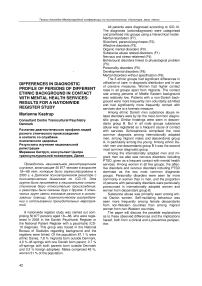Различия диагностического профиля людей разного этнического происхождения в контакте со службами психического здоровья. Результаты изучения национальной регистрации
Автор: Марианне Каструп
Журнал: Сибирский вестник психиатрии и наркологии @svpin
Рубрика: Тезисы докладов международной конференции по психоонкологии "Культура, мозг, тело"
Статья в выпуске: 3 (50), 2008 года.
Бесплатный доступ
Проводилось национальное регистрационное изучение, включающее 50 877 человек в возрасте 18-66 лет, которые были зарегистрированы в 2003 г. в Датском психиатрическом регистре с психиатрическим диагнозом по ICD-10. Эта группа была прослежена в национальном статистическом бюро относительно происхождения, и регистры были связаны друг с другом. 5 этнических групп имели значимые различия в использовании помощи, диагностическом распределении и использовании принудительных мероприятий.
Короткий адрес: https://sciup.org/14295268
IDR: 14295268
Текст статьи Различия диагностического профиля людей разного этнического происхождения в контакте со службами психического здоровья. Результаты изучения национальной регистрации
Проводилось национальное регистрационное изучение, включающее 50 877 человек в возрасте 18—66 лет, которые были зарегистрированы в 2003 г. в Датском психиатрическом регистре с психиатрическим диагнозом по ICD-10. Эта группа была прослежена в национальном статистическом бюро относительно происхождения, и регистры были связаны друг с другом. 5 этнических групп имели значимые различия в использовании помощи, диагностическом распределении и использовании принудительных мероприятий.
A nationwide register study was carried out comprising 50 877 persons aged 18—66, who were registered in 2003 in the Danish Psychiatric Register or the National Patient Register with a psychiatric ICD-10 diagnosis. This group was traced in the National Bureau of Statistics regarding background and the registers were linked. Of the population 87,1 % were ethnic Danes, 7,8 % migrants born outside Denmark, 4,0 % off-springs with one Danish born parent, 0,7 % off-springs with both parents born outside Denmark and 0,3 % foreign adoptees. Males comprised 49 %, women 51 % of the population.
All patients were diagnosed according to ICD-10. The diagnoses (actiondiagnoses) were categorised and prioritised into groups using a hierarchical model. Mental retardation (F7).
Skizofreni, paranoid psychoses (F2).
Affective disorders (F3).
Organic mental disorders (F0).
Substance abuse related disorders (F1).
Nervous and stress-relatered (F4).
Behavioural disorders linked to physiological problem (F5).
Personality disorders (F6).
Developmental disorders (F8).
Mental disorders without specification (F9).
The 5 ethnic groups had significant differences in utilization of care, in diagnostic distribution and in use of coercive measures. Women had higher contact rates in all groups apart from migrants. The contact rate among persons of Middle Eastern background was relatively low. Patients with a non-Danish background were more frequently non-voluntarily admitted and had significantly more frequently contact with services due to a forensic measure.
Among ethnic Danish men substance abuse related disorders were by far the most common diagno-sitic group. Similar findeings were seen in descendants group B. But in all male groups substance abuse was registered as a frequent cause of contact with services. Schizophrenia comprised the most common diagnosis among internationally adopted men, among migrant males and descendants group A, in partilularly among the young. Among ethnic Danish men and descendants group B it was the second most common diagnostic group.
Among the internationally adopted men and migrant men we also saw nervous disorders including PTSD, given as a frequent contact with mental health services. Among women in all five groups, the affective disorders and nervous disorders including PTSD dominate as the two most common diagnostic groups. Personality disorders were seen far more commonly in women than in men, and the proportion of persons with personality disorders were particularly pronounced in internationally adopted women and women from descendant group B.
Substance abuse was primarily seen among ethnic Danish women. Self-mutilating behaviour was seen more frequently among female descendants from non-Western countries than among migrant women from non-Western countries.
The paper will discuss the possible explanations as to these observed differences and the implications hereof, both from a clinical and a preventive perspective.


